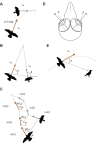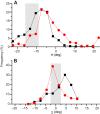Falcons pursue prey using visual motion cues: new perspectives from animal-borne cameras
- PMID: 24431144
- PMCID: PMC3898623
- DOI: 10.1242/jeb.092403
Falcons pursue prey using visual motion cues: new perspectives from animal-borne cameras
Abstract
This study reports on experiments on falcons wearing miniature videocameras mounted on their backs or heads while pursuing flying prey. Videos of hunts by a gyrfalcon (Falco rusticolus), gyrfalcon (F. rusticolus)/Saker falcon (F. cherrug) hybrids and peregrine falcons (F. peregrinus) were analyzed to determine apparent prey positions on their visual fields during pursuits. These video data were then interpreted using computer simulations of pursuit steering laws observed in insects and mammals. A comparison of the empirical and modeling data indicates that falcons use cues due to the apparent motion of prey on the falcon's visual field to track and capture flying prey via a form of motion camouflage. The falcons also were found to maintain their prey's image at visual angles consistent with using their shallow fovea. These results should prove relevant for understanding the co-evolution of pursuit and evasion, as well as the development of computer models of predation and the integration of sensory and locomotion systems in biomimetic robots.
Keywords: Avian vision; Falcon; Motion camouflage; Predation; Pursuit-evasion.
Figures






Similar articles
-
Physics-based simulations of aerial attacks by peregrine falcons reveal that stooping at high speed maximizes catch success against agile prey.PLoS Comput Biol. 2018 Apr 12;14(4):e1006044. doi: 10.1371/journal.pcbi.1006044. eCollection 2018 Apr. PLoS Comput Biol. 2018. PMID: 29649207 Free PMC article.
-
RETROSPECTIVE STUDY OF ASPERGILLOSIS IN JUVENILE FALCONS IN UNITED ARAB EMIRATES: PREVALENCE AND EFFECT OF HYBRIDIZATION.J Zoo Wildl Med. 2024 Dec;55(4):893-900. doi: 10.1638/2024-0067. J Zoo Wildl Med. 2024. PMID: 39699136
-
How fast can raptors see?J Exp Biol. 2020 Jan 2;223(Pt 1):jeb209031. doi: 10.1242/jeb.209031. J Exp Biol. 2020. PMID: 31822552
-
Outrun or Outmaneuver: Predator-Prey Interactions as a Model System for Integrating Biomechanical Studies in a Broader Ecological and Evolutionary Context.Integr Comp Biol. 2015 Dec;55(6):1188-97. doi: 10.1093/icb/icv074. Epub 2015 Jun 27. Integr Comp Biol. 2015. PMID: 26117833 Review.
-
The visual system of diurnal raptors: updated review.Arch Soc Esp Oftalmol. 2017 May;92(5):225-232. doi: 10.1016/j.oftal.2016.11.019. Epub 2017 Feb 13. Arch Soc Esp Oftalmol. 2017. PMID: 28209509 Review. English, Spanish.
Cited by
-
Ecological processes determining the distribution dynamics of vole populations during forest succession.Oecologia. 2018 Nov;188(3):721-732. doi: 10.1007/s00442-018-4261-9. Epub 2018 Sep 22. Oecologia. 2018. PMID: 30244315
-
Bio-logging, new technologies to study conservation physiology on the move: a case study on annual survival of Himalayan vultures.J Comp Physiol A Neuroethol Sens Neural Behav Physiol. 2017 Jul;203(6-7):531-542. doi: 10.1007/s00359-017-1180-x. Epub 2017 Jun 13. J Comp Physiol A Neuroethol Sens Neural Behav Physiol. 2017. PMID: 28612235 Free PMC article.
-
Stealth and deception: Adaptive motion camouflage in hunting broadclub cuttlefish.Sci Adv. 2025 Mar 28;11(13):eadr3686. doi: 10.1126/sciadv.adr3686. Epub 2025 Mar 26. Sci Adv. 2025. PMID: 40138425 Free PMC article.
-
From Paths to Routes: A Method for Path Classification.Front Behav Neurosci. 2021 Jan 21;14:610560. doi: 10.3389/fnbeh.2020.610560. eCollection 2020. Front Behav Neurosci. 2021. PMID: 33551764 Free PMC article.
-
Using collision cones to assess biological deconfliction methods.J R Soc Interface. 2016 Sep;13(122):20160502. doi: 10.1098/rsif.2016.0502. J R Soc Interface. 2016. PMID: 27655669 Free PMC article.
References
-
- Abu Dhabi Sports Council (2011). Falcon Eye Abu Dhabi 2011, www.youtube.com
-
- Alerstam T. (1987). Radar observations of the stoop of the peregrine falcon Falco peregrinus and the goshawk Accipiter gentilis. Ibis 129, 267-273
-
- Ballerini M., Cabibbo N., Candelier R., Cavagna A., Cisbani E., Giardina I., Orlandi A., Parisi G., Procaccini A., Viale M., et al. (2008a). Empirical investigation of starling flocks: a benchmark study in collective animal behaviour. Anim. Behav. 76, 201-215
Publication types
MeSH terms
Grants and funding
LinkOut - more resources
Full Text Sources
Other Literature Sources

